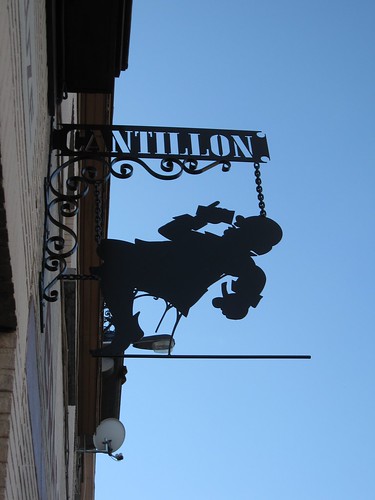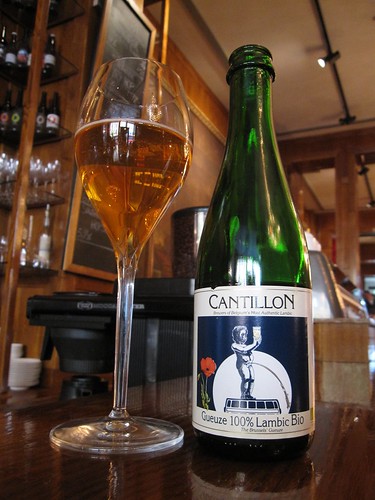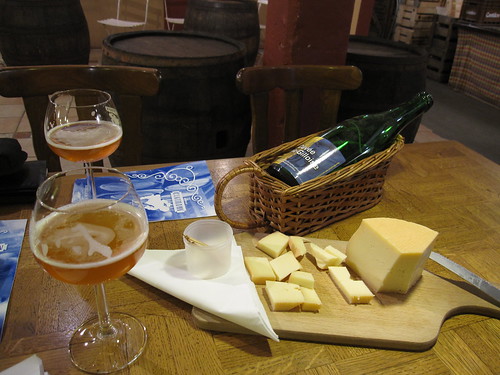 |
| The iconic Cantillon sign outside the brewery. |
Early history - the founding
Located in Rue Gheude 56 in the Anderlecht district of southwest Brussels, just a couple of blocks from the Gare du Midi train station, Cantillon was founded at its present address in 1900 by one Paul Cantillon.Paul was the son of a Lembeek brewer and had purchased an old warehouse, dating back to 1874, to start blending gueuze which was all the rage in Brussels in those days - most cafés would blend their own gueuze from lambics bought from lambic breweries in Pajottenland - just outside the city.
Initially, there were no plans of brewing lambic at Cantillon. It was Paul's sons, Marcel and Robert, who took this next step. They set about purchasing some second hand equipment and manufacturing a copper mash tun, and in November 1937 the first lambic wort flowed into the coolship at Cantillon - a new lambic brewery was born, and inside the city of Brussels.
In 1962, the twenty year old teacher Jean-Pierre Van Roy met a lovely young girl, Claude Cantillon, without realizing she was the daughter of Marcel Cantillon, then owner and head brewer of Cantillon. Claude and Jean-Pierre fell in love and eventually married, in 1967. The same year they received a son and a future brewer, Jean. Two years later, his father-in-law told him "either you take over or I close the brewery". Jean-Pierre duly did, learrning the art of brewing lambic from his father-in-law.
 |
| A copper brewing kettle from 1937 still in use at Cantillon. |
Recent history - sticking to traditions
When Jean-Pierre took over the brewery in 1969, he decided to stick with the Cantillon name. For several decades, Jean-Pierre battled an uphill struggle to keep the lambic tradition alive in Belgium, at a time when most other lambic brewers either closed or started producing sweet, fruit beers. |
| The classic Cantillon Gueuze 100% Lambic Bio. |
In September 2009, Jean-Pierre brewed his last batch of lambic, leaving the brewing and gueuze blending to the great-grandson of the brewery's founder: His own son, Jean Van Roy. Jean has learned the art of lambic brewing and gueuze blending by his father's side, over the last twenty years, even introducing some of his own ideas - such as the famed Zwanze series - before taking over as the new head brewer of Cantillon.
Jean Van Roy has shown a greater will to experiment than his father, creating a number of new sour ales and even introducing Roman-style ceramic amphoras for maturing lambic instead of the traditional oak. As of 2012, the Cantillon brewery seems to be in very good and capable hands with the fourth generation of the Cantillon-Van Roy family in charge.
Public Brewing Session
Twice a year, one Saturday in March and one Saturday in November, Cantillon hosts a Public Brewing Session, where visitors can come in and watch the entire process of brewing a traditional lambic. On November 12, 2011, I attended one such brewing session and here follows a few photos and a brief account of that experience.Brewing a lambic is a time consuming enterprise, because of the unusually long boiling times of 3-6 hours, so the brewing day starts early. At cantillon at 7 am. So get up early if you want to witness it all. Here's a typical brewing schedule:
 |
| Hot water and ground malt going into the mash tun at Cantillon. Notice the leakage! |
Witness the ground malt getting mixed with hot water and poured into the mash tun to extract the fermentable wort. Pay attention to all the cranky mechanics used to close and open ancient valves, and look for sudden leaks that are handled by placing a bucket on the floor.
09-12: Transfer to brew kettle
Witness the filtration and hopping of the wort as it gets ready for transfer to the brew kettle.
12-15: Boil-in
The hopped wort is boiled in two large copper brew kettles for at least three hours, reducing the liquid from 10,000 litres to 7,500 in order to raise the gravity of the wort, break up starches and reduce the bitterness of the hops.
15:30 Coolship
After the long boiling, the wort is pumped to the coolship upstairs, just underneath the ceiling, where the wort is allowed to cool overnight and become germinated with the wild yeast - Brettanomyces bruxellensis - living in the walls of the old brewery. The next day, the cooled wort will be transferred into big oak barrels, formerly used for aging red wines in Bordeaux or Rioja, for primary fermentation, which may take a couple of months, and then aging for up to three years.
 |
| The coolship at Cantillon is located right under the ceiling. |
The Cantillon Public Brewing Sessions are very popular events in Brussels so the small brewery will quickly feel swamped by people, so it's smart to be there when the brewery opens at 6:30 am and take the very first tour, before the line of people with cameras gets too long. If you do that, you can sit down at the brasserie section and enjoy some of their lambics and gueuze while watching new visitors line up for the later tours.
Cantillon is also open for visits outside the Public Brewing Sessions, both the brasserie and the brewery / museum (self-guided tours). On Mondays to Fridays they're open from 9 am to 5 pm and on Saturdays from 10 am to 5 pm.
 |
| A bottle of Cuvée Saint-Gilloise and gueuze cheese at Cantillon. |
Photo sets from my visits to Cantillon can be found at Flickr: May and November 2011.
No comments:
Post a Comment